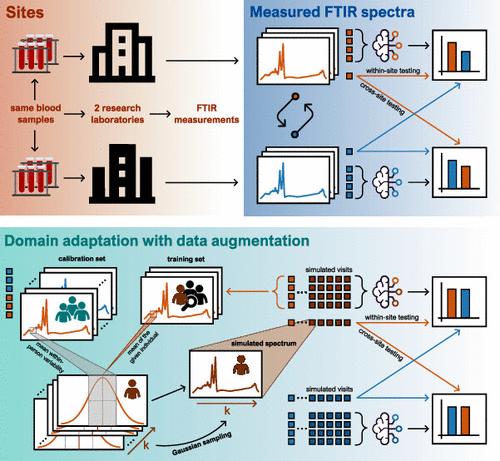Bridging Spectral Gaps: Cross-Device Model Generalization in Blood-Based Infrared Spectroscopy
IF 6.7
1区 化学
Q1 CHEMISTRY, ANALYTICAL
引用次数: 0
Abstract
This paper presents a solution to the challenge of cross-device model generalization in blood-based infrared spectroscopy. As infrared spectroscopy becomes increasingly popular for analyzing human blood, ensuring that machine learning models trained on one device can be effectively transferred to others is essential. However, variations in device characteristics often reduce model performance when applied across different devices. To address this issue, we propose a straightforward domain adaptation method based on data augmentation incorporating device-specific differences. By expanding the training data to include a broader range of nuances, our approach enhances the model’s ability to adapt to the unique characteristics of various devices. We validate the effectiveness of our method through experimental testing on two Fourier-Transform Infrared (FTIR) spectroscopy devices from different research laboratories, demonstrating improved prediction accuracy and reliability.

弥合光谱差距:血液红外光谱跨设备模型推广
针对血液红外光谱中跨设备模型泛化的难题,提出了一种解决方案。随着红外光谱在分析人体血液方面越来越受欢迎,确保在一台设备上训练的机器学习模型可以有效地转移到其他设备上是至关重要的。然而,当应用于不同的设备时,设备特性的变化通常会降低模型的性能。为了解决这个问题,我们提出了一种基于数据增强的直接域适应方法,该方法结合了设备特定的差异。通过扩展训练数据以包含更广泛的细微差别,我们的方法增强了模型适应各种设备独特特征的能力。我们通过不同研究实验室的两个傅里叶变换红外(FTIR)光谱设备的实验测试验证了我们的方法的有效性,证明了预测的准确性和可靠性。
本文章由计算机程序翻译,如有差异,请以英文原文为准。
求助全文
约1分钟内获得全文
求助全文
来源期刊

Analytical Chemistry
化学-分析化学
CiteScore
12.10
自引率
12.20%
发文量
1949
审稿时长
1.4 months
期刊介绍:
Analytical Chemistry, a peer-reviewed research journal, focuses on disseminating new and original knowledge across all branches of analytical chemistry. Fundamental articles may explore general principles of chemical measurement science and need not directly address existing or potential analytical methodology. They can be entirely theoretical or report experimental results. Contributions may cover various phases of analytical operations, including sampling, bioanalysis, electrochemistry, mass spectrometry, microscale and nanoscale systems, environmental analysis, separations, spectroscopy, chemical reactions and selectivity, instrumentation, imaging, surface analysis, and data processing. Papers discussing known analytical methods should present a significant, original application of the method, a notable improvement, or results on an important analyte.
 求助内容:
求助内容: 应助结果提醒方式:
应助结果提醒方式:


